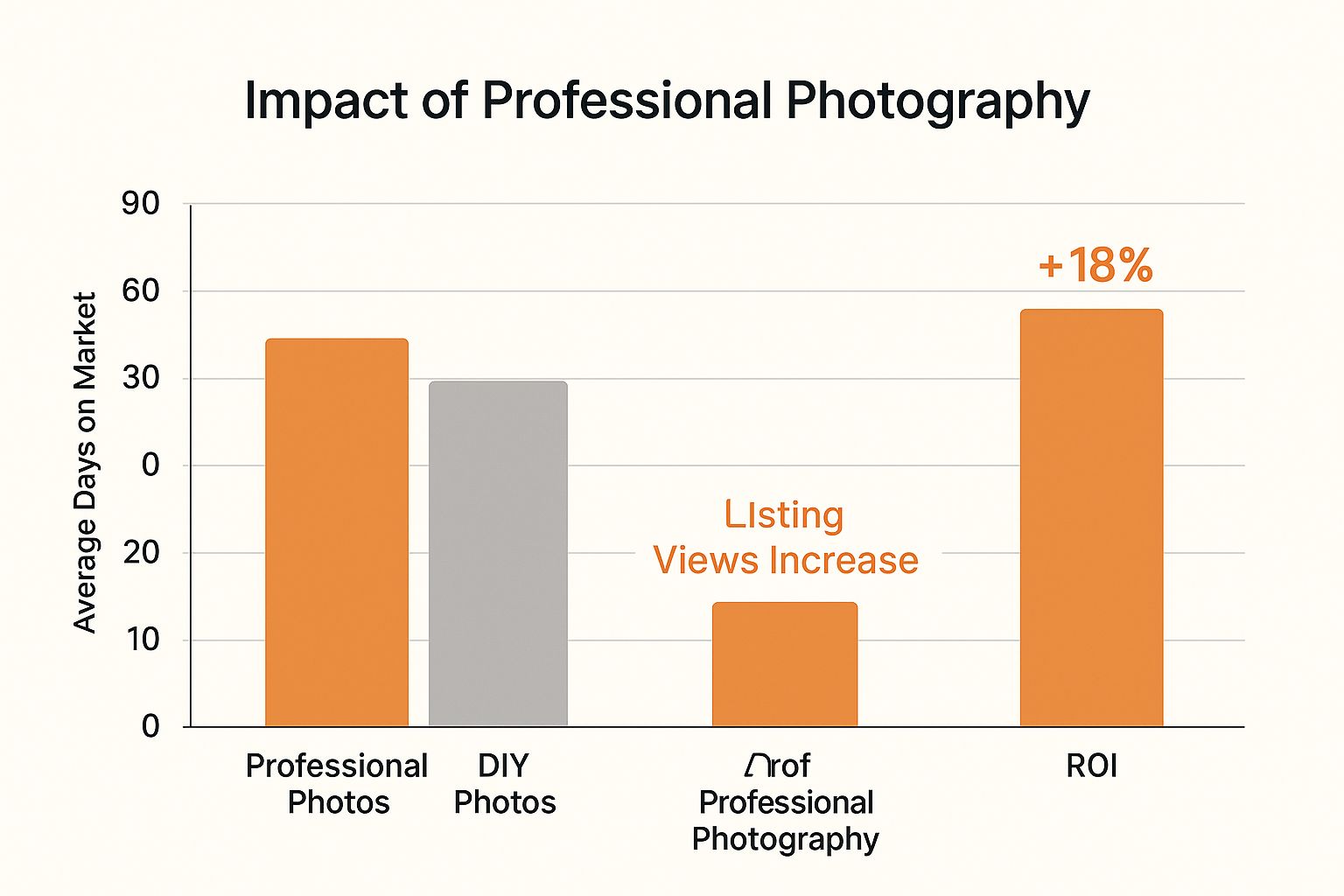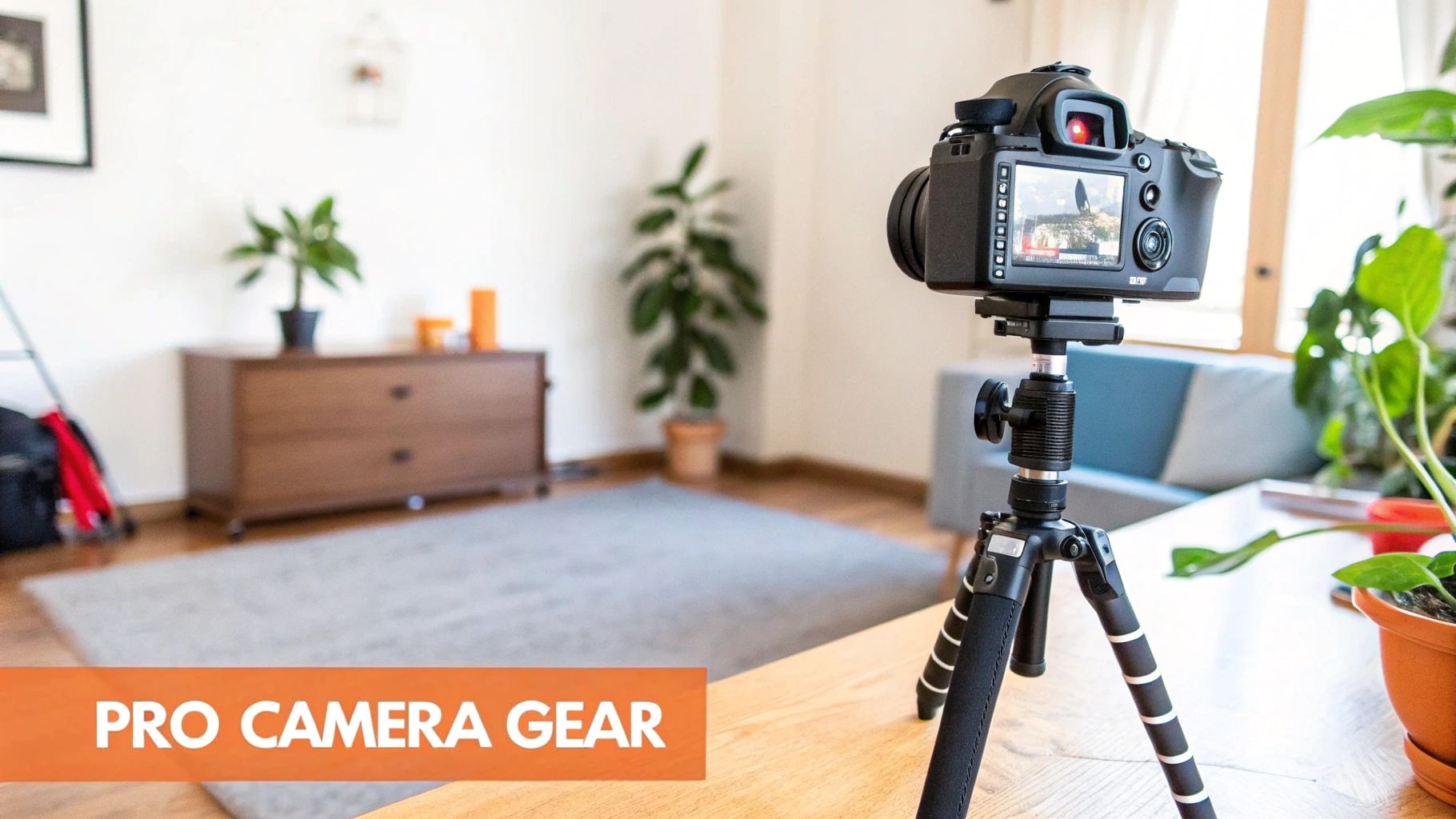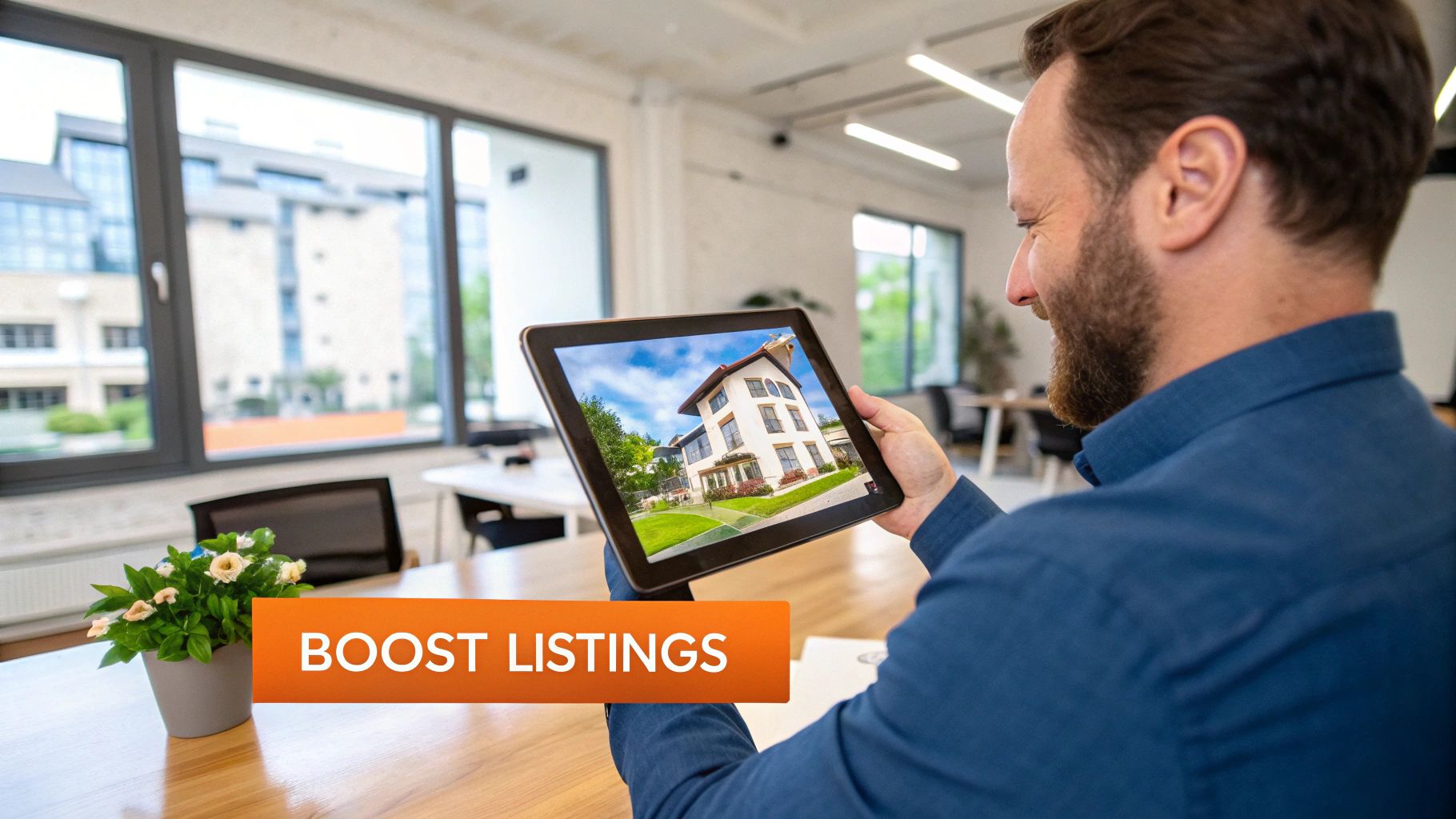Why Great Photography Sells Properties Faster
In the competitive real estate market, captivating visuals are essential for attracting potential buyers. High-quality real estate photography isn't simply about aesthetics; it's a strategic investment that significantly impacts a property's selling time and final price. Professional photography can be the key to a quicker, more profitable sale.
The Psychology of Visual Marketing
Buyers, especially those beginning their search online, are heavily influenced by a listing's first impression. Professional photographs highlight a property's best features, creating an emotional connection that generates interest and encourages further exploration. Much like a well-dressed salesperson instills confidence, high-quality images project an image of quality and care, suggesting a well-maintained property. This positive online first impression translates directly to increased in-person showings. You might be interested in: How to master home staging.
Data-Driven Results: Professional vs. Amateur
The impact of professional real estate photography is clear. The infographic below presents key data comparing listings with professional photos, DIY photos, and no photos. It highlights the differences in average days on market, increases in listing views, and return on investment (ROI).

To further illustrate the benefits of professional photography, let's take a look at a table summarizing the impact:
This table compares key performance metrics between listings with professional and amateur photography.
| Performance Metric | Professional Photography | Amateur Photography | Percentage Difference |
|---|---|---|---|
| Listing Views | Significantly Increased (+118%) | Lower | +118% |
| Average Sale Price | Increased (+8%) | Lower | +8% |
| Days on Market | Reduced (89 days) | Higher (123 days) | -28% |
| Likelihood of Sale within Listing Period | 84% Higher | Lower | +84% |
As the infographic and table demonstrate, professional photography significantly reduces time on market, increases listing views by 118%, and boosts the average sale price by 8%. This makes a compelling argument for investing in quality visuals. The National Association of Realtors (NAR) reports that 100% of home buyers start their search online, and 85% consider photos the most important factor when evaluating a property online. Listings with professional photos spend an average of 89 days on the market compared to 123 days for homes without. Furthermore, homes with professional photography have an 84% higher chance of selling within the listing period. Learn more about the impact of photography in real estate here.
Case Studies and Real-World Examples
Numerous case studies comparing identical properties marketed with different photography styles demonstrate the dramatic impact of professional images. From increased click-through rates to higher final offers, the data consistently reveals that professional photography elevates a property's perceived value and marketability. For instance, a dimly lit, amateur photo of a kitchen might make it appear small and unappealing. A professionally taken image, with proper lighting and composition, can showcase the same kitchen as bright, spacious, and inviting. These details can significantly influence a buyer's decision.
Essential Gear That Won't Break Your Budget

Creating stunning real estate photography doesn't have to be expensive. Let's explore building a budget-friendly kit for professional-quality images. This involves focusing on core equipment and smart investments.
Must-Have Basics
To begin, you'll need a few essential pieces of equipment:
- A Reliable Camera: While a full-frame camera offers top-tier image quality, an APS-C or even Micro Four Thirds camera can produce excellent real estate photos. Prioritize features like wide dynamic range and strong low-light performance.
- A Wide-Angle Lens: This lens type is crucial for capturing the full scope of a room. A focal length between 16-35mm (full-frame equivalent) is recommended.
- A Sturdy Tripod: A tripod is essential for sharp images, particularly in low light. It also maintains consistent framing for techniques like HDR blending.
- A Remote Shutter Release: This handy tool minimizes camera shake, further enhancing image sharpness, especially during longer exposures.
Smart Upgrades and Lenses
As your budget and skills develop, consider these upgrades:
- A Flash Unit: A speedlight provides greater control over lighting, filling in shadows, especially in tricky interior settings.
- A Second Lens: A prime lens with a wider aperture (like f/1.8) excels in low light and creates a shallow depth of field to emphasize details.
- A Panorama Head: This specialized tripod head simplifies creating seamless panoramic images, perfect for showcasing large rooms and expansive views.
For more guidance, check out our detailed guide on cameras for real estate photography.
Renting vs. Buying
Some specialized gear, like tilt-shift lenses for architectural photography, can be quite pricey. Renting these for specific projects is often more cost-effective than buying, especially when starting out. This gives you access to professional-level equipment without the hefty upfront cost.
Comparing Entry-Level and Pro-Grade Gear
This table highlights the key differences between entry-level and pro-grade equipment:
| Feature | Entry-Level | Pro-Grade |
|---|---|---|
| Image Quality | Good, suitable for most needs | Excellent, superior low-light performance and dynamic range |
| Durability | Generally less rugged | Built to withstand professional use |
| Features | Basic features | Advanced features for greater control |
| Cost | Budget-friendly | Significant investment |
Choosing the right gear is all about balancing your budget with your specific requirements. By focusing on essential items and strategically upgrading as your business grows, you can produce compelling real estate photography without overspending.
Mastering Light: The Key to Showcase-Worthy Images

Light plays a vital role in real estate photography. It can transform a simple room into an inviting space. Many photographers find mastering light a challenge. This section will explore professional lighting techniques to help you capture stunning images that resonate with potential buyers.
Scheduling Shoots for Optimal Natural Light
Using natural light effectively is the first step. This involves scheduling your photoshoots strategically. Consider the property's orientation. Morning light works well for east-facing properties, creating a warm ambiance. West-facing properties, however, look best in the soft, golden light of the afternoon.
South-facing properties are typically well-lit throughout the day, with midday sun offering the most brightness. North-facing properties often present a challenge, sometimes requiring extra lighting. Therefore, carefully planning your shoot time and understanding light direction is essential.
Simple Lighting Setups for Common Challenges
Even with the best planning, lighting challenges will arise. Dark interiors may need strategically positioned flashes or off-camera lighting. For aerial perspectives, consider the best drone for professional photography. Drones can offer impressive views and add valuable context to your real estate photos.
Balancing exterior and interior exposures can be tricky. HDR blending helps capture details in both bright and shadowed areas, significantly improving the final image quality.
Room-Specific Lighting Approaches
Different rooms call for different lighting strategies. In kitchens, highlighting under-cabinet lighting can create depth and warmth. Bathrooms often benefit from soft, diffused light for a relaxing, spa-like feel.
Challenging spaces with limited natural light or awkward angles can be transformed with creative solutions. A simple reflector can brighten a dark corner by bouncing light, improving the overall feel of the space.
Enhancing Perceived Value and Appeal
Mastering light goes beyond technical skill; it's about visual storytelling. By understanding how light interacts with a space, you can showcase a property's best features and create images that connect with potential buyers.
Highlighting architectural details or showcasing a cozy fireplace can evoke an emotional response, turning a house into a home in the buyer's imagination. This connection can boost perceived value and help sell the property faster.
Composition Strategies That Highlight Selling Points
Real estate photography isn't just about taking snapshots; it's about crafting a compelling story. Thoughtful composition elevates a property listing, strategically using camera position, height, and angle to create a sense of spaciousness, flow, and desirability. This is where the true artistry comes into play.
Creating Perceived Spaciousness and Flow
Where you position your camera drastically impacts a room's perceived size. A lower angle can make a room feel larger, while a higher vantage point showcases ceiling height and architectural details. Choosing the right lens, typically a wide-angle, helps capture the whole room without distortion.
The flow of a room guides the viewer's eye. Compositional techniques like leading lines, such as a hallway leading to a bright window, draw the viewer in, creating depth and a sense of exploration.
Showcasing Different Architectural Styles and Floor Plans
Different properties call for different approaches. A modern, minimalist home benefits from clean, symmetrical shots emphasizing geometric lines and open space. A cozy cottage, however, shines through warm compositions highlighting charming details and intimate spaces. Understanding a property's unique character is key to effective visual storytelling.
To better understand how to tailor your photography approach to each property type, refer to the table below.
To understand how to best capture different property types, see the table below outlining some best practices. It details how lens choices, angles, and considerations can significantly impact the final image.
| Property Type | Recommended Lenses | Key Shooting Angles | Special Considerations | Common Challenges |
|---|---|---|---|---|
| Modern Apartment | Wide-angle, prime lenses | Low angles for spaciousness, highlighting geometric lines | Minimalist staging, focus on natural light | Capturing the scale of open-plan layouts |
| Cozy Cottage | Prime lenses, macro lens for details | Eye-level angles, capturing intimate spaces | Highlighting textures, warm lighting | Limited space, managing clutter |
| Historic Home | Wide-angle, tilt-shift lens | Angles that emphasize architectural features, grand staircases | Balancing historical accuracy with modern appeal | Uneven lighting, showcasing intricate details |
| Suburban Home | Wide-angle for exteriors, prime lenses for interiors | Variety of angles, showcasing curb appeal and interior flow | Highlighting family-friendly features, landscaping | Capturing the essence of suburban living |
| Commercial Property | Wide-angle, tilt-shift for perspective correction | Angles that maximize space and functionality, showcasing amenities | Clean and uncluttered staging, emphasizing natural light | Balancing detail with overall impression of space |
This table provides a starting point for tailoring your photographic approach to various property types. Remember to consider the unique features of each space and adjust your techniques accordingly.
Emphasizing Best Features and Minimizing Less Appealing Aspects
Real estate photography is all about highlighting strengths. A well-composed shot emphasizes a beautiful fireplace or stunning view while minimizing less desirable aspects. This might involve strategic furniture placement or using lighting to create a focal point. Proper lighting is essential. Consider under cabinet lighting for added impact.
Visual Narratives and Mental Mapping
Professional real estate photographers create visual narratives. They mentally map a property, visualizing how a potential buyer might experience the space. This pre-visualization allows them to capture a sequence of images that guides the viewer through the property naturally and compellingly.
Residential vs. Commercial: Specialized Approaches
Residential photography focuses on creating a warm, inviting atmosphere. Commercial real estate photography emphasizes functionality, size, and potential use. This might involve showcasing amenities, highlighting natural light, or demonstrating foot traffic flow.
Understanding these nuances is crucial for creating effective real estate photography that attracts the right audience and drives successful sales.
Beyond Still Photos: Technologies That Win Listings

Real estate photography is constantly changing. New technologies give agents exciting new options for showcasing properties and attracting buyers. This section explores those advancements, concentrating on practical uses and their return on investment (ROI).
Aerial Photography: Taking Listings to New Heights
Aerial photography, especially using drones, offers a unique perspective impossible with traditional photography. Drones capture expansive views, showcasing the surrounding area and highlighting key features. Think landscaping, pools, and proximity to desirable amenities. This broad perspective helps potential buyers visualize the property and its location – a critical factor in their decision-making.
For instance, a drone shot can perfectly capture a large backyard, something hard to convey with ground-level photos. They can also highlight nearby parks, schools, or shopping centers, providing valuable context for buyers.
Virtual Tours: Immersive Experiences That Drive Engagement
Virtual tours create immersive experiences, allowing potential buyers to explore a property from anywhere. These 360-degree walkthroughs give buyers a realistic sense of the space, layout, and flow, helping them imagine themselves living there.
This is especially helpful for out-of-town buyers or those with busy schedules, eliminating the need for multiple in-person visits. Virtual tours also increase buyer engagement, leading to more qualified leads. They simply offer a more complete and engaging viewing experience than static images can.
The growth of real estate photography is clear, with advanced visual tools becoming more common. By 2025, 82% of real estate agencies were using drones, and homes with aerial photos sold 68% faster. Around 22% of home listings now include virtual tours, offering immersive experiences for potential buyers. Learn more from these real estate photography statistics.
Integrating Technology for Comprehensive Marketing Packages
Smart real estate agents are incorporating these technologies into complete marketing packages. By combining professional photography, aerial shots, and virtual tours, they create dynamic and eye-catching presentations. These packages showcase properties in the best possible way, maximizing their appeal.
The ROI of Emerging Technologies
While these technologies require an upfront investment, the potential ROI is significant. Aerial photography and virtual tours can reduce time on market, boost buyer interest, and ultimately lead to higher sale prices.
These tools allow agents to offer premium marketing services, justifying higher commissions and attracting more listings. Investing in technology isn't just about showcasing properties; it's about building a modern, tech-savvy brand. Agents who embrace innovation and leverage technology will gain a competitive edge and position themselves for greater success.
Editing Workflows That Maintain Authenticity
Post-processing is where good real estate photography becomes great. It's the art of transforming raw images into compelling visuals that tell a property's story. However, there's a fine line between enhancement and misrepresentation. This section explores ethical editing workflows that elevate a property's appeal while maintaining authenticity.
Essential Editing Sequence for Real Estate Images
Professional real estate photographers typically follow a specific editing sequence to ensure consistency and quality. The workflow usually begins with global adjustments, such as correcting white balance and exposure. This establishes the foundation for further edits.
Next, they'll address perspective distortion, a common problem with wide-angle lenses. Correcting vertical and horizontal lines helps rooms appear more natural and balanced. This step is followed by local adjustments, focusing on specific areas within the image, such as brightening shadows or reducing glare.
Finally, color correction and contrast adjustments add vibrancy and depth. The aim throughout this process is to enhance, not fabricate, the reality of the property.
Time-Saving Workflows and Consistency
Maintaining consistency across a set of property images is crucial for a professional presentation. Using presets in editing software like Adobe Lightroom can significantly speed up the workflow. Presets help ensure a uniform look and feel across all photos.
Think of a preset as a recipe for editing. It applies a pre-defined set of adjustments, saving time and effort. This ensures a cohesive visual narrative throughout the property's photos.
Correcting Perspective, Balancing Light, and Window Exposures
Wide-angle lenses, while essential for capturing spacious interiors, can distort lines. This can make rooms appear unnatural. Perspective correction tools in editing software help straighten these lines, creating a more accurate depiction. This process is especially important for properties with distinctive architectural features. For a more detailed explanation, check out our guide on real estate photo editing services.
Balancing mixed lighting can be a challenge. This is particularly true when natural light from windows combines with artificial interior lights. Techniques like HDR blending, which combines multiple exposures, help capture detail in all areas. This creates a balanced and natural-looking image.
Window pull, where the view outside is overexposed, is a common issue. Correcting this involves carefully adjusting the window area's exposure. This reveals the outside view without losing interior detail.
Ethical Considerations and Avoiding Misrepresentation
While enhancing images is acceptable, misrepresenting a property is unethical. Removing permanent fixtures, dramatically altering room sizes, or concealing structural flaws is misleading. This can also have legal consequences. The goal of real estate photography is to present a property attractively while maintaining accuracy.
Presenting an accurate depiction builds trust with potential buyers and prevents issues later.
Buyer Engagement and the Impact of Over-Processing
Subtle use of techniques like HDR blending can increase buyer engagement. However, over-processed images often deter buyers. These images are characterized by overly saturated colors, unrealistic HDR effects, and excessive sharpening. They look artificial and can raise doubts about the property's actual condition.
A nuanced approach to editing is essential. The goal is to enhance the image, not create a fantasy.
Acceptable Improvement vs. Misleading Manipulation: Defining the Boundaries
Understanding the difference between acceptable enhancement and misleading manipulation is crucial for ethical real estate photography. Adjusting brightness, contrast, and color saturation to create a more appealing image is generally acceptable.
However, digitally adding non-existent features, removing permanent fixtures, or drastically changing the property's appearance is unethical. It's also potentially misleading. By adhering to ethical editing practices, photographers build trust and contribute to a transparent real estate market. This involves a commitment to accuracy and a focus on enhancing reality, not fabricating it.
Looking for a simpler way to enhance real estate photos? Pedra, an AI-powered software, offers a range of tools for virtual staging, realistic renders, and photo enhancements – all with a single click.
